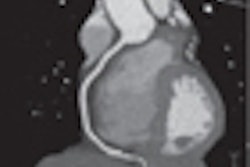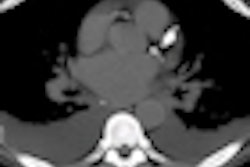Cardiac CT is safe, accurate, and cost-effective in low-risk patients presenting with chest pain, according to a scientific statement published by the American Heart Association (AHA) of Dallas.
Low-risk patients presenting with chest pain are increasingly managed in chest pain units that perform accelerated diagnostic protocols. In this setting, the use of CT angiography is rapidly expanding, primarily due to published studies demonstrating cost-effectiveness and safety in a low-risk population, wrote Ezra Amsterdam, MD, and colleagues on behalf of an American Heart Association committee that issued the statement (Circulation, August 11, 2010, Vol. 122, pp. 756-776).
"Hospitals and cardiologists are increasingly turning to [cardiac CT] to determine who of those presenting to the emergency room can be safely discharged from the hospital in a timely fashion," the group wrote.
Most of the 8 million patients a year presenting with chest pain in the U.S. don't have a life-threatening condition, but clinicians must distinguish those who need urgent care from individuals with more benign diseases who do not require admission.
"Inadvertent discharge of patients with acute coronary syndrome from the emergency department is associated with increased mortality and liability, whereas inappropriate admission of patients without serious disease is neither indicated nor cost-effective," they wrote. Along with clinical judgment and basic tools such as physical exams and electrocardiograms, newer diagnostic methods including cardiac imaging exams have extended clinicians' diagnostic capacity.
Patients with negative findings usually complete the accelerated diagnostic protocol with a confirmatory test, generally an exercise treadmill test or a cardiac imaging study, to exclude ischemia. Along with rest myocardial perfusion imaging, "computed tomography coronary angiography has shown promise in this setting," they wrote.
"A negative accelerated diagnostic protocol evaluation allows discharge, whereas patients with positive findings are admitted," they wrote. "This approach has been found to be safe, accurate, and cost-effective in low-risk patients presenting with chest pain."
Newer large, randomized studies that are not yet published -- such as the Computed Tomographic Angiography for the Systematic Triage of Acute Chest Pain Patients to Treatment (CT-STAT) study -- "further reinforce the utility of this modality and the safety, efficacy, and cost savings compared to other imaging tests," the Society of Cardiovascular Computed Tomography (SCCT) said in a statement accompanying the release.
Related Reading
ACC task force releases 2010 policy on CTA, CMR, May 19, 2010
JACC special issue tackles radiation dose in cardiac imaging, May 14, 2010
FDA changes PMA advisory panel process, April 27, 2010
NEJM study: Imaging procedures, radiation growing, August 26, 2009
ASE issues echocardiography contrast consensus statement, November 11, 2008
Copyright © 2010 AuntMinnie.com




















